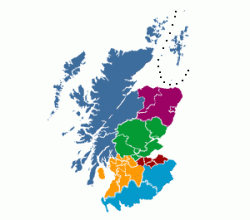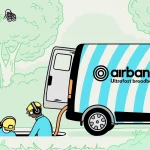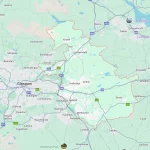UPD2 Royal Society of Edinburgh Says Scotland to Miss 30Mb Broadband Target

Scientists writing for the Royal Society of Edinburgh (Digital-Scotland Working Group) have warned that the Scottish Government’s Step Change programme, which apparently now aims to make BT’s “superfast broadband” network available to “around” 95% of local premises by the end of 2017-18, will actually only achieve less than 80%.
The University of Edinburgh based group, which claims to have used all of the available data but admits that “the information published to date, is entirely inadequate“, predicts that less than 80% of Scottish households will have access to superfast broadband by the end of 2017-18 and that the Government’s target is thus “not credible“.
Advertisement
It adds that at least 45% of the 450,000 households in rural Scotland will not receive superfast broadband from the current programme and thus the long-term prospects for the final 15% of the country are said to be “dismal“, unless a plan to achieve 100% (e.g. the EU’s 2020 target) is developed.
Digital-Scotland Working Group Statement
“In 2001 the Scottish Government published a report correctly identifying the need for rural Internet and a suggesting a good strategy for delivering it. At present Scotland has no plans that will achieve the EU target of 30 Mb/s to all by 2020. It has no plans for delivering it to the final 15% of its population, which includes almost half of its rural households.
Rather than assuming that a virtual monopoly of the telecommunications infrastructure will solve the problem if given enough money, the Scottish Government needs to act quickly, decisively and independently in order to avert the likelihood that yet another generation of rural inhabitants will miss out on the opportunities for social, political, and economic development afforded by the Internet.
Without regulated open access to the publicly subsidised core infrastructure, sufficient to enable communities and third-parties to develop and maintain alternatives to the too-long copper connections – alternatives that must support both domestic and business connections – we see no way forward for those left behind by Step Change.”
The conclusion, which is summarised in this blog, then begins to elaborate on its calculations and we immediately spotted an oddity. Earlier press releases stated that BT’s “fibre broadband” (FTTC/P) network would become available to “around” 95% of local premises by the end of 2017, which doesn’t specifically state that 95% will get “superfast speeds” of 30Mbps+ (i.e. the dominant FTTC service can deliver a minimum speed of 2Mbps+).
However the Scottish Government’s Budget 2014-15 Draft does now state that “95 per cent of premises in Scotland will have access to superfast broadband by the end of 2017-18“, although admittedly the latest updates have tacked on 2018 and thus effectively added an extra year to the original target.
The report then proceeds to break the data down and suggests that around 84% of Scotland’s households are served from street cabinets, with below 79% being connected to a cabinet by less than 1.2 km of copper. “If every cabinet is upgraded, all of these homes should be able to order a superfast connection“, it claims. It similarly notes that one third of Exchange Only Lines (EOL), which don’t use a street cabinet, may be short enough to deliver superfast speeds.
Advertisement

Digital-Scotland Working Group Statement
“On the negative side, not all exchanges and cabinets will be converted, our speed estimates are based on the copper wiring being in good condition, and our estimates are conservative (they assume that the lengths of exchange-only lines are similar to those of lines that go via cabinets, but we believe that many will be longer).
We therefore expect that the real situation will be much worse. For the final 16% – over half a million households – there is no upgrade path in sight: those on long copper lines will be left behind, not able to enjoy superfast speeds using the technologies currently being deployed.”
Crucially it’s not clear from this prediction whether the report has factored in how BTOpenreach will also need to build many new street cabinets, which aren’t always in the same locations as the old ones and this can impact FTTC performance. On the other hand the public data is limited and they state that, “there are no details of points of presence, not even their positions, nor of the products that will be offered.”
Similarly EOL’s may also benefit from new street cabinet based infrastructure later on in the deployment (example), although Openreach has so far been unable to answer our questions about their final approach to those.
Suffice to say that there is a wide margin for error and the numbers do not take account of households receiving Virgin Media’s cable broadband, although admittedly most of those are in urban areas anyway and so arguably their impact should not be significant. Never the less it might still impact the results by a few per cent, although you can’t be sure unless it’s included.
We have asked BT for their opinion of the results and are awaiting their reply. But we would stress that if anything the study is better as an argument for why more data to support the 95% claim should be released, as opposed to the above being a reliable indicator of the end result. The unknowns must be removed before we can find some truth.
Advertisement
UPDATE 9:37am
The source report has just been updated to correct for “a bug in the software used to the figures in an earlier version of this post“. We have adjusted the relevant figures above.
UPDATE 4:47pm
BT has furnished us with an official response, albeit through the Digital Scotland project.
A Spokesman for the Digital Scotland Superfast Broadband project told ISPreview.co.uk:
“This analysis is incorrect. We don’t recognise these figures and they are not representative of what will be achieved. The research is not based on actual line length data. The figures do not appear to take account of engineering procedures used to maximise speeds over long lines or the potential use of fibre to the premises beyond the reach of copper.
There have been significant improvements to the reach and speed of fibre in the last four years. We expect the pace of innovation to continue. We are also working on new fibre-based technologies to overcome some of the challenges.
The Broadband Delivery UK framework defines superfast speeds at 24Mbps. Using this baseline would immediately see a sharp rise on the claimed coverage. The Step Change projects will ensure that 85 per cent of Scottish properties have access to fibre broadband by the end of 2015 and around 95 per cent by the end of 2017.
Our focus is on bringing fibre-based technologies to the most people possible within the budget available. Thanks to this investment, the vast majority of homes and businesses in rural Scotland can look forward to significantly faster broadband speeds.”
It’s worth pointing out that Scotland originally defined superfast broadband as offering download speeds of 30Mbps, thus the above figure of 24Mbps+ (note: this is used by the UK government but not Ofcom or the EU) might confuse matters. Similarly the above statement refers to the 95% figure as being “fibre broadband” again but doesn’t clarify if this is “superfast” and if so, whether that’s 24Mbps+ or 30Mbps+. Fun.
Mark is a professional technology writer, IT consultant and computer engineer from Dorset (England), he also founded ISPreview in 1999 and enjoys analysing the latest telecoms and broadband developments. Find me on X (Twitter), Mastodon, Facebook, BlueSky, Threads.net and Linkedin.
« Sky’s Internet Based NOW TV Service Hampered by UK Rights Restrictions























































Comments are closed